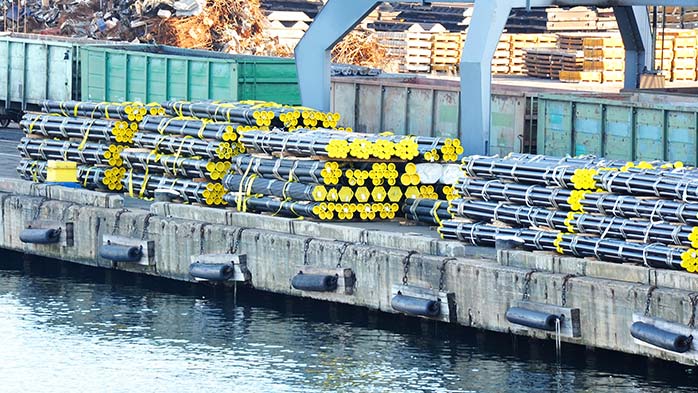
The drive for a green recovery after Covid-19 has also served to generate unprecedented momentum behind hydrogen technologies as a tool for global decarbonisation. Both factors have led to a rapid escalation in the race to develop green ammonia projects. Green credentials alone will not be sufficient for all to achieve financing, and developers should develop a solid business case from the outset.
In this insight, CRU Consulting sets out some of the key commercial questions project developers will need to answer for potential investors, based on our extensive experience of assessing the market feasibility of nitrogen projects for the financial community.
Demand for low carbon fertilizers is set to grow
The global population continues to grow, driving demand for fertilizers to support the agricultural productivity gains required to meet world crop demand. At the same time, however, there is increasing pressure from policymakers, investors and consumers to produce fertilizers in a more environmentally sustainable way. This is a particular challenge for nitrogen fertilizer producers, with the focus on carbon-intensive ammonia, the raw material for nitrogen fertilizers. Conventional “brown ammonia” (or grey ammonia) production, using fossil fuels (mostly gas) and steam methane reforming, is currently responsible for roughly 1% of world CO2 emissions, and over time producers face rising carbon pricing and broader market access issues if they fail to respond to these emerging expectations.
In response, the development of “green ammonia” production, using renewable energy and electrolysis to replace fossil fuels as the hydrogen source for carbon free ammonia, has been gaining traction. Over 2019 and 2020 the pipeline and scale of green ammonia projects has expanded rapidly, with recent announcements from Saudi Arabia, Europe, the US, and Australia, amongst others. At the same time, “blue ammonia” – the use of carbon capture and storage (CCS) and fossil fuels to produce low-carbon ammonia – is also expanding, albeit arguably to a lesser degree. We are also starting to hear more about turquoise ammonia, involving the conversion of natural gas into carbon black and hydrogen via methane pyrolysis which can be carbon free where renewable energy is solely used (see Figure 1).

DATA: CRU
Widespread support from governments, companies, and broader society for a green recovery post Covid-19 has resulted in rapid momentum building for the hydrogen economy as a tool to enable global decarbonisation (see section below: Covid-19 – a blessing in disguise for green ammonia?). Increasing recognition of ammonia’s potential role in enabling the hydrogen economy has accelerated the development of green, blue and turquoise ammonia projects. However, near weekly announcements of low carbon ammonia projects does mean increased competition for financing for project developers, and green credentials allow will not be sufficient for all to reach development. Projects can still become first movers and find financing by considering early whether they are commercially feasible from the perspective of potential investors.
Covid-19 – a blessing in disguise for green ammonia?
The arrival of Covid-19 has posed some risk to the commercialisation of low carbon nitrogen technologies. The ability of companies to make significant “clean” investments is constrained by Covid-19 on account of reduced liquidity and credit availability. Additionally, green financing, a potential source of project finance, initially took a hit due to Covid-19, for example green bonds declined by over a quarter in the first half (H1) of 2020 from H1 2019 levels, according to the Climate Bonds Initiative. The crisis has also reduced global gas demand and prices, potentially undermining the relative competitiveness of green ammonia versus brown ammonia.
There has also been the risk that cash-strapped governments could prioritise short-term stimulus measures to prop up economies over future-oriented clean investments, such as green hydrogen. However, governments have instead been urged to fight the two crises of Covid-19 and climate change at once, using investments in low-carbon technologies to stimulate economic growth. This approach found some success boosting renewable energy investment after the 2008-2009 financial crisis.
Encouragingly for green ammonia project developers, so far in the Covid-19 period growing numbers of governments have heeded these calls, promoting low carbon investments, including hydrogen. The European Union (EU), as well as countries such as Australia, Chile, Germany, Norway, Portugal, and UK, have all made public commitments to develop the hydrogen economy. This poses opportunities for green ammonia projects, by offering improved access to direct financing and other incentives, such as preferential taxation and subsidies. Most encouragingly, China’s announced commitment to net zero emissions by 2060 also improves the potential there for development of hydrogen and CCS based technologies.
The investment community is also playing a strong role in the post Covid-19 green recovery. Growing numbers of financial institutions are appraising investments based on their long term sustainability, and reducing lending to fossil fuel sectors. As a result, green financing has rebounded strongly in the second half of 2020, with the Climate Bonds Initiative reporting Q3 2020 as the second highest quarter ever for green bonds issuance.
Prepare strong commercial business case early to win financing race
Even with renewed government backing and green financing opportunities, green ammonia projects will still need to compete for support and financing against similar projects, but also other technologies (e.g. blue and turquoise ammonia) and other green hydrogen applications (e.g. steel, hydrogen fuel cells, etc – see here on green steel). To win this race, we urge that project owners give careful thought early on as to each project’s commercial proposition and competitive positioning.
Based on CRU Consulting’s considerable experience acting as lenders’ market consultant to numerous ammonia and other nitrogen projects, we have identified below in Table 1 key areas of focus for developers and investors assessing the feasibility of green ammonia projects. The divergence in project configurations, ranging from small-scale localised plants in isolated fertilizer markets and retrofits to the front-end of existing ammonia plants of fertilizer focused producers, through to large scale greenfield plants enabling the hydrogen economy, mean that the importance of these different commercial considerations will vary greatly between projects.

Even for an investor with prior experience of nitrogen investments, green ammonia projects can demand an increased appetite for risk. From a commercial perspective, two major areas for investor concern are likely to be the ability of the project to place its planned sales volumes in existing and nascent markets, and its economic feasibility versus brown ammonia producers.
De-risk entry into nascent green ammonia markets
Green ammonia producers potentially have access to markets that brown ammonia competitors (at least in the long term) cannot reach. In addition to selling carbon free ammonia to more traditional fertilizer and mining explosive markets, nascent energy markets hold great potential. Options include grid scale energy storage/generation, direct fuel for use in fuel cells (most promisingly in marine applications), or as a hydrogen carrier, where as a more easily transportable form of hydrogen using existing global logistics and storage infrastructure, it is distributed globally for cracking back to carbon free hydrogen at the point of consumption.

DATA: CRU
These enhanced green credentials are no doubt attractive to investors, but as a basis for their financing decisions, investors will still require credible scenarios for market development, and a clear understanding of how the project will de-risk the many uncertainties associated with nascent markets. CRU Consulting have in depth experience and rigorous methodologies for assisting project developers to build and strategically align sales and marketing strategies. Our analysis and advice are based on solid market knowledge, a client-centric approach, and experience of assisting other projects developing markets with new applications, as in our technology metals and electric vehicles work.
Stress-test project against alternative green scenarios
It is not just in relation to future demand in green markets where investors will be required to take a leap of faith, but also regarding future cost competitiveness and product pricing versus brown ammonia. The elevated costs levels of green ammonia vis-à-vis brown ammonia remain a source of concern for investors. In forthcoming insights, we will be looking more at this cost differential, and the ability and timescale for green ammonia to bridge this gap. Investors should not however discount green ammonia projects too soon, but take a long term view and consider their individual configurations and costs. Important aspects for developers and investors to consider are:
1) Delivered costs – Projects should be evaluated on a delivered (not site) cost basis and in view of netback pricing versus competitors. The economics of green ammonia projects in difficult to reach markets, such as South America or Africa, could work, as could integrated or nearby offtakers. The cost of cracking (e.g. for conversion of ammonia back into hydrogen) also needs to be assessed for some business models.
2) Carbon pricing and policies - Changes in carbon prices across geographies will also serve to redistribute global commodity cost curves (see here for more details) including those in nitrogen, with green ammonia producers set to be amongst the winners. More commitments to carbon neutrality and abatement by governments as part of the green recovery may accelerate this shift.
3) Renewable versus gas prices and energy policy - For green ammonia projects, the evolving differential between renewable energy and gas prices (including carbon pricing) will serve to test their long term competitiveness and profitability versus brown ammonia. Using forecasts from our Economics team and our extensive knowledge of global energy policy, CRU Consulting helps clients to understand the most likely scenarios for feedstock pricing.
4) Green premium - The development of a green premium for carbon free ammonia will boost projects’ revenues, but in the face of a current lack of certification and price benchmark, this may not yet prove bankable enough for more risk-adverse investors. CRU Consulting is actively studying the drivers and impact of potential green premia across commodity markets (please see here for more discussion), and can assist in determining likely scenarios for a green ammonia premia.
5) Trade policy - Trade policy changes can also impact the competitiveness of projects. In particular, the introduction of carbon border tax adjustments (CBTA) in different geographies will likely enhance green ammonia’s competitiveness, most likely in the EU (see here for more details).
We appreciate the need for project developers and investors to stress-test projects through the modelling of alternate assumptions for these key drivers. We provide these using independent, consistent, and rigorous analysis and logical narratives at the micro and macro levels. Utilising robust price forecasting methodologies and detailed cost databases, CRU Consulting has excellent experience building alternative and coherent market scenarios for commodity producers and projects, including detailed decarbonisation scenarios. This approach is hugely insightful for green ammonia projects seeking to test their economic feasibility under alternative scenarios.
By failing to prepare, you are preparing to fail
Covid-19 could be a turning point for the development of green ammonia, bringing projects increased opportunities for financing, access to markets, and improvements in project economics. Nonetheless, not all the fast-growing number of green ammonia projects will succeed. To win the race for financing, developers should build and stress test early a rigorous commercial business case for their project. CRU Consulting has deep expertise, data and methodologies, to help you develop a bankable business case to advance your project. Please contact CRU via the button below to discuss this topic in more detail.
Explore this topic with CRUThe Latest from CRU

Decarbonisation will reshape global steel trade flow
CRU’s Steel Long Term Market Outlook presents comprehensive analysis of global steel trade flows until 2050. Decarbonisation will play a significant role in redefining...


